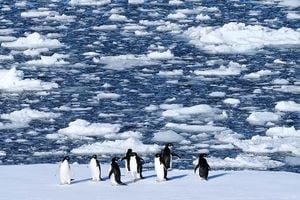High above the Amazon rainforest, invisible streams of moisture known as “flying rivers” have long sustained the region’s lush biodiversity and the livelihoods of millions. But as scientists sound the alarm over their weakening, the consequences are rippling across South America—worsening droughts, threatening hydroelectric power, and putting entire ecosystems at risk. With the United Nations Climate Summit (COP30) just weeks away in Belém, Brazil, the fate of the Amazon and those who depend on it has become a global concern, with political leaders and scientists alike calling for urgent, coordinated action.
According to the Associated Press, these flying rivers are not literal bodies of water, but vast, invisible flows of moisture carried by winds from the Atlantic Ocean across the continent. The rainforest itself acts as a giant pump: trees absorb water from the soil and release it back into the atmosphere, relaying rain thousands of miles westward. As Matt Finer, a senior researcher with Amazon Conservation’s Monitoring of the Andean Amazon Project (MAAP), explains, “These are the forces that actually create and sustain the Amazon rainforest. If you break that pump by cutting down too much forest, the rains stop reaching where they need to go.”
Yet relentless deforestation, driven by cattle ranching, soy farming, and infrastructure projects, is disrupting this critical water cycle. Over the past two years, the Amazon has experienced its driest conditions on record. Southern Peru and northern Bolivia are especially vulnerable, as the flying rivers’ dry-season routes now pass over southern Brazil—precisely where tree loss is most severe. The result? Failed harvests, scorched forests, and cities left in the dark as hydroelectric dams run dry.
Brazilian climate scientist Carlos Nobre, who helped coin the term “flying rivers” in 2006, has long warned of a tipping point: if deforestation exceeds 20 to 25 percent and global warming reaches 2 degrees Celsius, vast swaths of rainforest could transform into dry savanna. “The dry season is now five weeks longer than it was 45 years ago, with 20 to 30% less rainfall,” Nobre told the Associated Press. “If deforestation exceeds 20 to 25% and warming reaches 2 degrees Celsius, there’s no way to prevent the Amazon from reaching the tipping point.”
The stakes go far beyond the Amazon itself. The rainforest stores immense amounts of carbon dioxide, helping to regulate the world’s climate. A shift to savanna would not only devastate wildlife and Indigenous communities but also threaten farming, water supplies, and weather stability across the continent and beyond.
For Indigenous peoples, the shifting climate is already upending traditional ways of life. Corine Vriesendorp, Amazon Conservation’s director of science in Cusco, Peru, noted, “The last two years have brought the driest conditions the Amazon has ever seen. Ecological calendars that Indigenous communities use—when to plant, when to fish, when animals reproduce—are increasingly out of sync. Having less and more unpredictable rain will have an even bigger impact on their lives than climate change is already having.”
But as the environmental crisis deepens, political leaders in the Amazon region are making their case on the world stage. With COP30 scheduled to convene in Belém, Governor Helder Barbalho of Pará is seizing the moment to demand greater climate finance from the world’s wealthiest nations. “We are positioned to help lower global temperatures, but we need climate finance for that,” Barbalho said at a recent panel, according to Valor Econômico. He criticized developed countries for “pointing fingers” at Brazil and demanding forest preservation while local communities lack adequate income and quality of life.
Barbalho’s message is clear: Brazil cannot bear the burden of conservation alone. He expects COP30 to be a turning point—“less talk and more delivery,” as he put it—with concrete commitments to support developing nations in their efforts to protect the rainforest. “Brazil has the standing to demand commitments from the largest economies. None of the world’s biggest economies does for the environment what Brazil is doing,” Barbalho asserted.
His counterpart, Governor Gladson Cameli of Acre, echoed the need to balance environmental preservation with economic development. “You don’t need to cut down a single tree to strengthen agribusiness,” Cameli said, emphasizing support for farmers and stricter enforcement against illegal deforestation and burning. Both governors championed land-tenure regularization—clarifying rights and responsibilities for land occupants—as a key strategy to reduce territorial conflicts and promote inclusive environmental protection.
Barbalho also highlighted the importance of building alternative economies that change the logic of land use, suggesting that forest stocks could become a “menu of income” for landowners. He pointed to Pará’s efforts to transition toward a low-carbon economy and the need for policies that enhance the value of sustainable practices. At the same time, he acknowledged the challenges of fighting illegal mining and the need for strong laws to ensure the traceability of extracted ore, with “vigorous enforcement” against irregular operations.
Despite international pressure to move COP30 from Belém due to concerns about infrastructure, Barbalho insisted that the summit must take place in the heart of the Amazon. Only by witnessing the region’s realities firsthand, he argued, can global leaders truly appreciate the scale of the challenge—and the urgency of the solutions required.
Scientists and policymakers alike agree that regional cooperation is essential. As Vriesendorp noted, “This can’t be solved by one country alone. Peru depends on Brazil, and Brazil depends on its neighbors. We need basin-wide solutions.” Finer, of MAAP, suggested that governments consider new conservation categories designed specifically to protect flying rivers—not just the land, but the atmospheric flows that sustain the rainforest itself.
The path forward, researchers say, is clear but daunting: zero deforestation, degradation, and fires—immediately—coupled with large-scale forest restoration and unwavering support for Indigenous land rights. “To avoid collapse we need zero deforestation, degradation and fires—immediately,” Nobre urged. “And we must begin large-scale forest restoration, not less than half a million square kilometers. If we do that, and keep global warming below 2 degrees, we can still save the Amazon.”
With the world’s eyes soon to be on Belém for COP30, the Amazon stands at a crossroads. The choices made in the coming months—by governments, communities, and the international community—will determine not only the fate of the rainforest but the global climate for generations to come.




